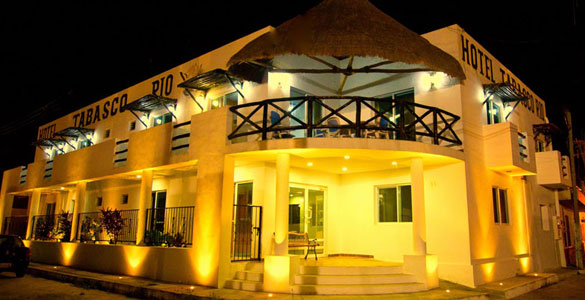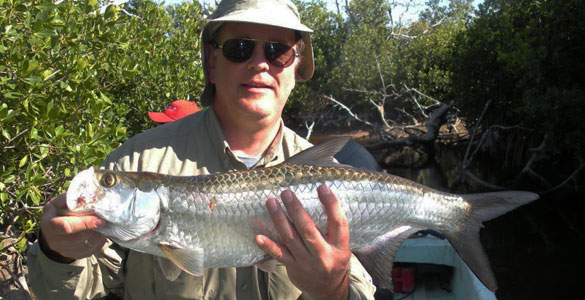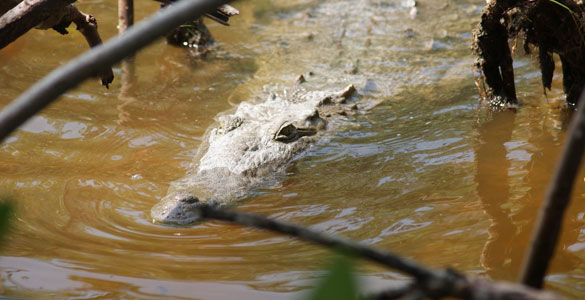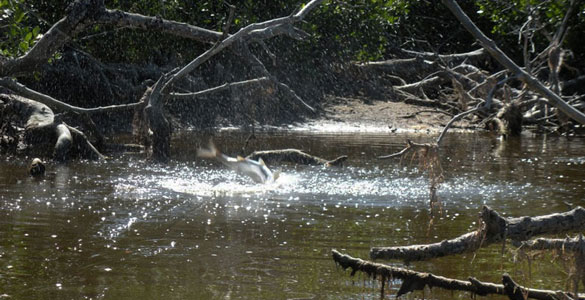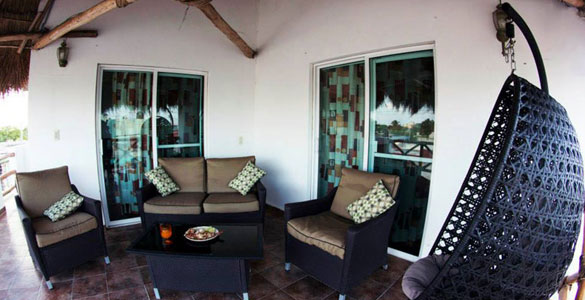Overview
Fly Fishing for Tarpon – Rio Lagartos
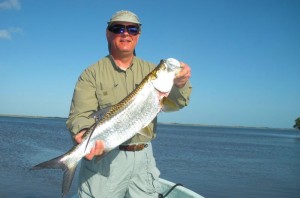
The northern Yucatan is famous for fly fishing for tarpon and this destination is one of m top 3 baby tarpon destinations in the world. Rio Lagartos is part of a National Park that holds huge populations of baby tarpon between 2 and 50 pounds. Add the migratory tarpon up to 200 pounds that arrive in the summer and you have a complete tarpon fishery. The town of Rio Lagartos is a sleepy fishing village on the edge of the preserve.
Accommodations at a nice local hotel are paired with the best guides in the preserve. The preserve has miles and miles of grass flats, mangrove creeks and lagoons to hunt for tarpon. Some of this is sight fishing and other time blind casting to a likely spot under the mangroves. You may need some weedless flies for this if your casting skills are a bit rusty when you are trying to lay it into that 12″ space in the mangroves!
The trip starts with your arrival in Cancun. You will make your way through customs and find the driver holding a sign with your name. From there it is about a 4 hour drive on paved roads through flat terrain to the town of Rio Lagartos. Every so often you will slow down for a small village . These villages are usually made up of Mayan descent.
Read More about Rio Lagartos
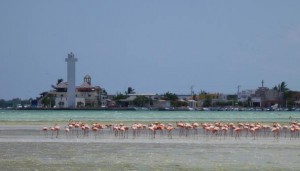
You will be driving to the village of Rio Lagartos on the northwestern edge of the Yucatan Peninsula. There is a nice hotel in town and it is your “lodge” for the trip. You will get breakfast and lunch there daily with dinners left on your own at one of the neighboring restaurants. The boats are just a block away at the marina.. The hotel is clean, modern and by far the best in town. It is not the Ritz! Breakfast is usually very early to make sure we get some good time in just as the light is coming up. Fly Fishing for tarpon means an early morning start as the tarpon are more active at night and in low light than during the heat of the day. We still find fish all day long it is just prime time very early. The hotel will prepare a lunch for us to enjoy out on the water. There is plenty of water and cervesa supplied with lunch as well. Dinners in town are a nice way to experience the local culture.

It takes 15-30 minute to reach the prime water. The guides know the tides and winds very well so they will direct the days fishing taking you to where the tides and wind conditions are most favorable. If it is nice and calm you might look for some of the bigger fish out in the open flats. If it is a bit windy you will head directly into the sheltered ares of the Rio Lagartos preserve. There are hundreds on miles of mangrove lined lagoons a creeks to choose from. All of them harboring baby tarpon. After returning to the hotel there will be some time to explore the little town, tie some flies and relax. This area has more baby tarpon than we have seen any where in the world. During spring and summer there is also an influx of large tarpon, that can be found if the weather is calm. These fish will travel in fairly large schools and once you find them, hookups are inevitable! Finding them is the hard part. Calm weather usually encourages tarpon to roll so this is a dead giveaway as to where they are! If the wind kicks up they are harder to find or it makes the boat ride too uncomfortable
Lodging
Fly Fishing for Tarpon – The Lodging

The accommodations at Rio Lagartos are comfortable, bright, and enriched with traditional Mexican decor. With the ocean at its doorstep, the sea breeze and beautiful scenery refreshes the spirit after a long day of fighting tarpon. A spacious lounge provides dining areas, comfortable seating for relaxing, and a nice workspace for fly tying or working on tackle at the day’s end.
As we venture upstairs, you will find spacious guest rooms equipped with air-conditioning, fans, and a full private bath with shower. Rooms are bright with a nice ocean view. There is a housekeeping service that cleans the room and replaces linens, towels, bottled drinking water, cups, and bar soap each day. A unique feature of the lodge is a nice rooftop balcony. It provides a splendid 360 degree view of the charming area surrounding the lodge – perfect for after-dinner relaxation.
In addition to world-class fishing, the hallmark of Rio Lagartos is their warm hospitality and top-level service. The staff members at Tarpon Cay Lodge are some of the most friendly and hardworking people you will ever meet. They are sincerely committed to making your stay comfortable and enjoyable.
The hotel and food are not fancy, just simple, clean and basic. There is not a honeymoon suite within 200 miles!
Fishing
Rio Lagartos – Fly Fishing for Tarpon
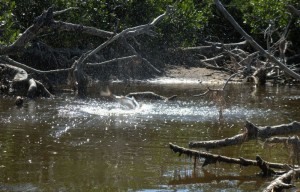
The tarpon fishing in this area is quite varied. There are open water flats with larger tarpon cruising around, Mangrove lined creeks and lagoons with mid sized tarpon cruising under the branches of the overhanging mangroves, inland lakes and lagoons . This is a nursery for fish between 2 and 50 pounds.
In the summer you have the addition of the migratory tarpon coming through the area. This is the same area accessed by Holbox or their summer fish.
These fish will be 50-200 pounds with most in the 60-80 pound range.
Snook are also in the mangrove areas and you will target these fish whenever we see them.
Tarpon are most active early in the morning saw we are usually off by dawn to the flats the guides have chosen to visit that the day. The area that has tarpon is quite large extending through the entire Rio Lagartos preserve. A good day of tarpon fishing means you might jump 10 20 fish – we have recorded a boat that jumped 50 fish in a day. Many tarpon are lost on one of the first few jumps so the percentage you actually get to the boat is low. 10-20% is the number that actually get all the way to the boat.Fly Fishing for tarpon here at Rio Lagartos is fly fishing heaven!
More About the Tarpon Fishing at Rio Lagartos
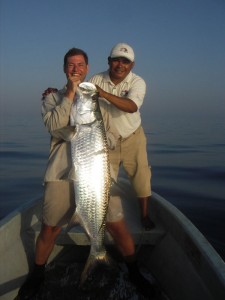
On the open flats your guide will pole and search for rolling tarpon ( which is about all you see when the light is low or as the sun gets higher you will be able to sight the fish in the clear water even if they are not rolling. Getting a tarpon to eat a fly is sometimes the easiest thing in the world of fly fishing or the most frustrating. Long follows are possible ending up in a refusal or a take 5 feet from the boat. Sometimes the tarpon attack as soon as they see movement, sometimes they spook just because the fly moves funny ( I don’t really know what funny is to a tarpon). Long casts are helpful out here in the open as it will increase your circle of effectiveness.
In the mangrove areas accuracy can be more important, slinging it under some branches or hitting the pocket between the overhanging mangroves is a more important skill than casting 100 feet. In many area the water is clear and in others it is stained to the color of tea. Still most fish are sighted first. Often the fish will be clear of the mangrove but more often they will cruise just under the overhanging branches. A hook up in there is usually followed by a leap over the branches and off the hook, but what a blast. Once in a while we get lucky and the tarpon blasts out into the open, you just never know!

There are some smaller creeks and inland lakes that have lots of small fish in the 2-5 pound range. These are very aggressive fish and blind casting is most effective. It doesn’t matter how big or small a tarpon is – they all jump once they are hooked. It is the best fighting game fish I know of. Add to that the fact that you can sight fish and hunt for these fish in shallow water and it is hard to argue that there is any better game fish on the planet.
Late spring and summer brings some larger fish into the mix as well, maybe over 100 pounds! These big fish are found between Holbox and Rio Lagartos and involve the open ocean so it requires some relatively calm weather to track down these migratory brutes. The trick is finding these schools as hookups are pretty common if you can find them.
I hope you get to experience this unique fishery while it is still undiscovered.
Fishing Photo Gallery
Tackle & Gear
Here is a list of the basics you will need for your trip. Many of our destinations are pretty remote with no chance to buy things on site.
[table id=90 /]
Fly List
[table id=89 /]
Packing List
[table id=18 /]
Rates
[table id=228 /]
Prices Include: round trip ground transportation from Cancun to the lodge, lodging, breakfast and lunch daily (dinner on your own in town), guided fishing each day ( for fishing packages), soft drinks. It also includes all taxes. Prices quoted are per person and in US dollars.
Prices do not include: Alcoholic beverages, dinners, fishing license or gratuities for your guide and resort staff
Why Book Through Flyfishingheaven.com?
Why book it through us when you could book direct?
[table id=108 /]
Our Pledge
[table id=93 /]
Payment and Cancelation Polices
[table id=107 /]
Seasons
[table id=1 /]
Gallery
Activities

If you don’t like fly fishing for tarpon then this destination may not be for your group.
The nice beach in some of the scenic pictures is actually a boat ride away!
Here are a few of the local non fishing activities which revolve around the preserve.
• Flamingo boat tour – 2 hour boat tour which takes you into the bio reserve to the feeding grounds of the flamingos.
Activities: Mayan mud bath, float in salt water, feeding the hawks, swimming at the beach.
• Crocodile night tour – this tour is also by boat and takes you into the bio reserve once the sun has set. Enjoy the night sky and quietness of the natural surroundings whilst we begin to hunt the crocodiles, using torches to see the reflection of their eyes. A great opportunity to see these amazing creatures up close in their natural habitat.
• Kayak – enjoy a trip into the bio reserve and mangroves by Kayak, our experienced guides will take you through the labyrinth of mangroves to experience the tranquility of the nature reserve up close.
• Bike routes – there are many routes around Rio lagartos. One of our favourites takes you to the Colorados and pink lakes followed by Peten Tucha, a small water hole where you can spot crocodiles, turtles and many birds. There is a small tower you can climb up to get a better view.
• Horse riding – Around 20 minutes drive from Rio Lagartos is Rancho Robles, where you can enjoy horse riding along a designated track. The trail takes you to a cenote (sink hole) with a bridge to enjoy the water and take a swim.
Travel
Fly Fishing for Tarpon – Travel Tips
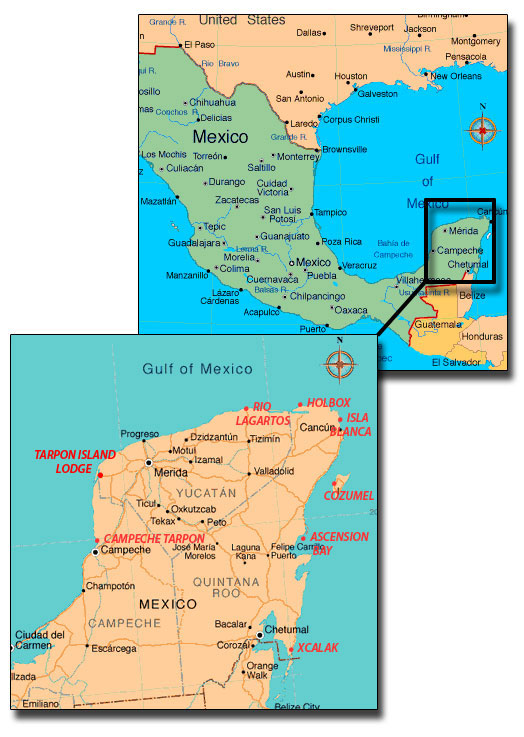
How To Get to RIo Lagartos
From your location, you will need to fly to Cancun International Airport. Most major USA, European, and Canadian cities have direct flights to Cancun. Upon arrival, a Tarpon Cay Lodge representative will greet you at the ground transportation area of the airport (just outside of Customs and Immigration.)
From Cancun, you will be driven 3 hours northwest in our shuttle van – a comfortable, air-conditioned extended van. The ride is very comfortable, as all roads traveled are paved and well maintained. During the drive, you will venture through the beautiful Yucatan countryside and a few very unique traditional Mexican towns.
Required Travel Documents
• A current U.S. passport is required for all United States citizens entering Mexico. It is highly recommended that U.S. citizens present a passport that is valid for at least six months after the last day of the trip. If your passport expires before then, please renew it prior to departing on your trip.
• If you hold citizenship in a country other than the United States, please check with your national consulate / passport center for citizenship documents required for travel to Mexico.
Packing List
[table id=18 /]


